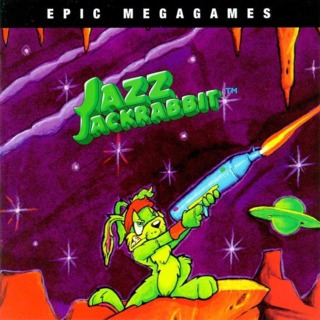Jazz Jackrabbit was arguably the fastest, richest, and most enjoyable platformer of its time.
In 1994, however, a young Dutch programmer named Arjan Brussee and the still relatively unknown Cliff Bleszinski made an ambitious effort to set things straight for platform-craving PC gamers. It was the year of Jazz Jackrabbit, a green rabbit with a blue gun and a red bandana, with whom you had to shoot your way through a large number of well-designed platform levels. The game obviously drew a lot of inspiration from Mario and Sonic. Especially the influence of the latter platform series is constantly noticeable, be it in the speedy gameplay or in the similar artistic design.
Jazz Jackrabbit is more than just a tribute to the exemplary games of its genre, though. The combination of smart level design, ultra-fast gameplay, and the crucial shooting element make for an experience that feels familiar and unique at the same time. The availability of a gun prevents the game from slowing down, as the players don't have to stop and jump on enemies in order to kill them. The addition of different weapon types (bouncing bullets, two-way rockets, flames) gives the combat element a strategic touch that was largely absent in the Mario and Sonic games.
This doesn't mean that level navigation falls to the background, though. While the earlier levels are still pretty straightforward, later stages include more (hidden) paths, mazes, and near impossible jumps and maneuvers, with the notorious bounce wall section in the second level of Orbitus being the best example. Other levels have unique gameplay applications, such as the changing water level in Dreempipes, and the magnets in Letni.
From an artistic point of view, Jazz Jackrabbit actually overclasses most of its contemporary rivals. The huge variation in superbly drawn environments displays the huge amount of attention and detail the developers put in creating a marvelous and exciting gaming world. From the toxic sci-fi planet Technoir to the dark goldmine of Crysilis: all worlds have their own characteristic look and feel, as well as some level-specific enemies to protect the worlds. After every 3 worlds (each of which consists of 2 levels), a boss will have to be dealt with before you move on to the next episode. These boss fights are quite challenging, and a lot of them require specific techniques rather than brainless shooting.
Additionally, the developers even included 3D bonus levels, all of which are mazes with gems hidden in them which Jazz must find before time runs out. Needless to say, these 3D levels all look very dated now, but back in their day, they were quite revolutionary. Keep in mind that 3D platforming quite simply didn't exist back then.
Arguably, the element that best reflects the atmosphere of the various alien worlds is the game's soundtrack. Composer Robert A. Allen did a smashing job at creating a heavy, fast, yet melodious score to go with the futuristic and active nature of the game. It's hard to name specific examples of great tunes without doing injustice to others, as all songs are nothing short exceptional. The tracks to worlds such as Crysilis, Tubelectric, and Medivo, however, manage to stick out. I'd even go as far as saying that every retro gamer should know the aforementioned tracks by heart.
Perhaps the only thing that hurts this title a bit is its length. Even though all levels are equally enjoyable and replayable, the main game ends after just a few hours. A couple of extra episodes have been included on the CD version of the game, but even then beating Jazz Jackrabbit barely takes half the time it does to beat, say, Super Mario Bros. 3. And that's without the magic whistles, you scavenger.
Jazz Jackrabbit certainly compensates in terms of fun, however, and with 5 different difficulty levels (some of which are actually very challenging), there's plenty of reason to replay the game a few times. Moreover, the questionable length of the main game is but a small dot on the quality of the overall package. Jazz Jackrabbit was arguably the fastest, richest, and most enjoyable platformer of its time. While not every part of the gameplay was as original as you'd hope, Jazz certainly gave the games it drew inspiration from a run for their money, and it almost single-handedly set a new standard for PC platforming. Perhaps even more importantly, the game is still very playable to this day. If you happen to run across a copy of this game (the CD version came free with every copy of the equally amazing Jazz Jackrabbit 2), don't hesitate to add it to your collection.

